Nano Starch and Composite Films: A Review on Development & Coatings
VerifiedAdded on 2023/01/19
|42
|18791
|74
Literature Review
AI Summary
This assignment provides a comprehensive review of nano starch and its application in the development of composite films and coatings for enhancing the shelf life of fruits. It delves into the isolation and characterization of nano starch from various botanical sources, including cereals, tubers, legumes, and non-conventional sources, using methods like acid hydrolysis, gamma radiation, and physical treatments. The review analyzes the impact of nano starch on the properties of composite films, such as thickness, solubility, color, moisture vapor transmission rate, mechanical properties, thermal properties, and biodegradability, emphasizing how these alterations influence fruit quality. Ultimately, the review highlights the potential of nano starch-based films as an effective means of securing and preserving food items, offering insights into the various factors affecting film production and characteristics.
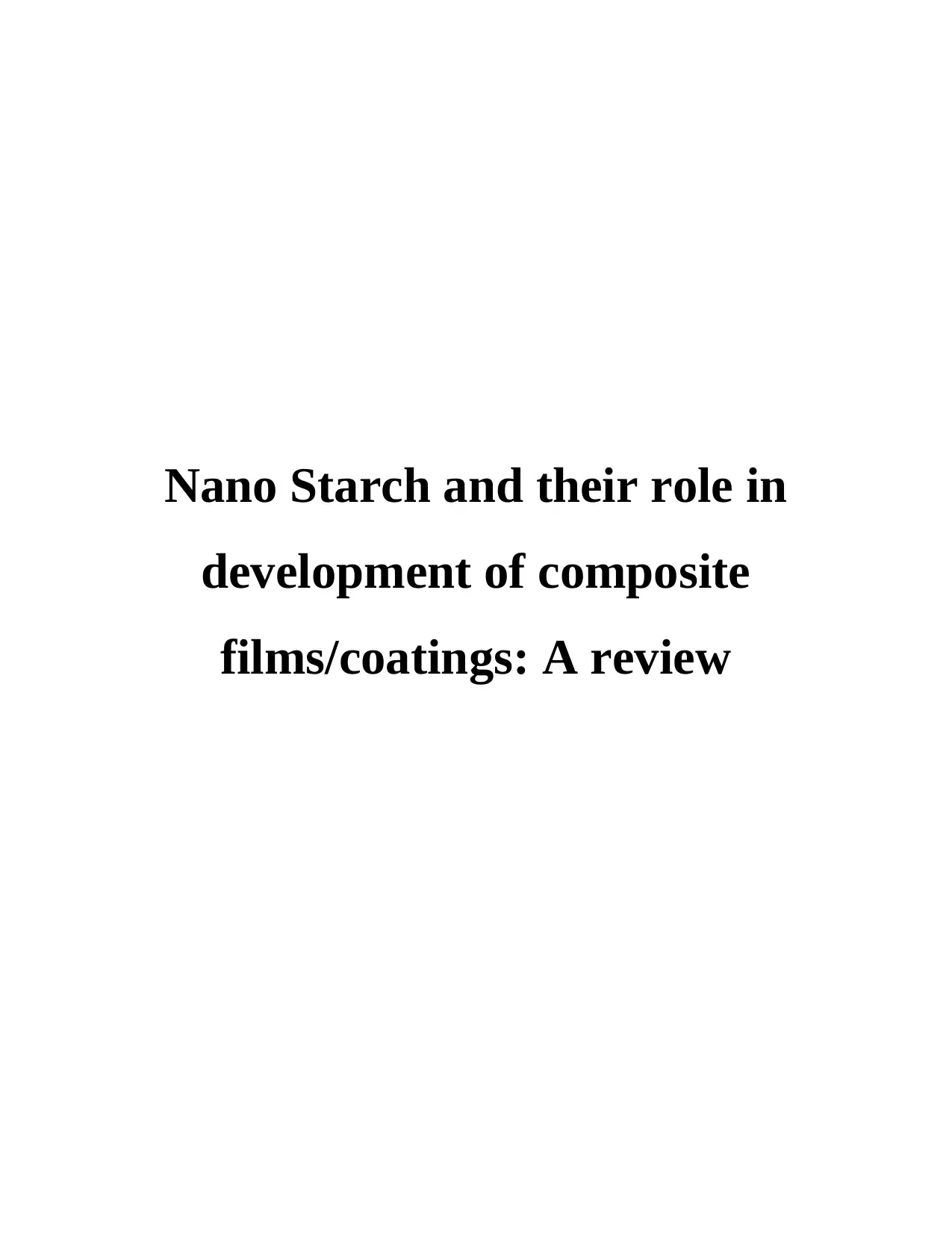
Nano Starch and their role in
development of composite
films/coatings: A review
development of composite
films/coatings: A review
Paraphrase This Document
Need a fresh take? Get an instant paraphrase of this document with our AI Paraphraser
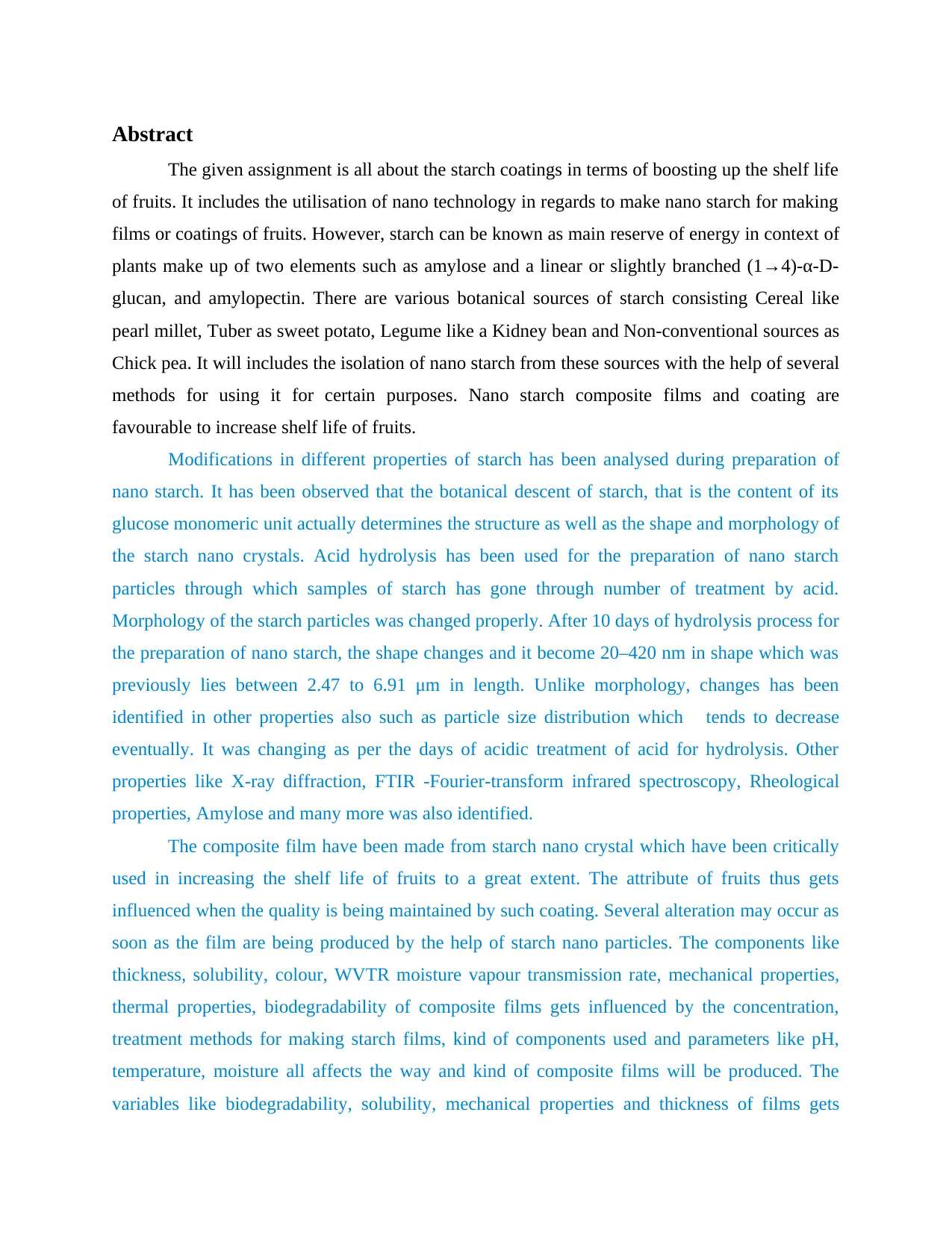
Abstract
The given assignment is all about the starch coatings in terms of boosting up the shelf life
of fruits. It includes the utilisation of nano technology in regards to make nano starch for making
films or coatings of fruits. However, starch can be known as main reserve of energy in context of
plants make up of two elements such as amylose and a linear or slightly branched (1→4)-α-D-
glucan, and amylopectin. There are various botanical sources of starch consisting Cereal like
pearl millet, Tuber as sweet potato, Legume like a Kidney bean and Non-conventional sources as
Chick pea. It will includes the isolation of nano starch from these sources with the help of several
methods for using it for certain purposes. Nano starch composite films and coating are
favourable to increase shelf life of fruits.
Modifications in different properties of starch has been analysed during preparation of
nano starch. It has been observed that the botanical descent of starch, that is the content of its
glucose monomeric unit actually determines the structure as well as the shape and morphology of
the starch nano crystals. Acid hydrolysis has been used for the preparation of nano starch
particles through which samples of starch has gone through number of treatment by acid.
Morphology of the starch particles was changed properly. After 10 days of hydrolysis process for
the preparation of nano starch, the shape changes and it become 20–420 nm in shape which was
previously lies between 2.47 to 6.91 μm in length. Unlike morphology, changes has been
identified in other properties also such as particle size distribution which tends to decrease
eventually. It was changing as per the days of acidic treatment of acid for hydrolysis. Other
properties like X-ray diffraction, FTIR -Fourier-transform infrared spectroscopy, Rheological
properties, Amylose and many more was also identified.
The composite film have been made from starch nano crystal which have been critically
used in increasing the shelf life of fruits to a great extent. The attribute of fruits thus gets
influenced when the quality is being maintained by such coating. Several alteration may occur as
soon as the film are being produced by the help of starch nano particles. The components like
thickness, solubility, colour, WVTR moisture vapour transmission rate, mechanical properties,
thermal properties, biodegradability of composite films gets influenced by the concentration,
treatment methods for making starch films, kind of components used and parameters like pH,
temperature, moisture all affects the way and kind of composite films will be produced. The
variables like biodegradability, solubility, mechanical properties and thickness of films gets
The given assignment is all about the starch coatings in terms of boosting up the shelf life
of fruits. It includes the utilisation of nano technology in regards to make nano starch for making
films or coatings of fruits. However, starch can be known as main reserve of energy in context of
plants make up of two elements such as amylose and a linear or slightly branched (1→4)-α-D-
glucan, and amylopectin. There are various botanical sources of starch consisting Cereal like
pearl millet, Tuber as sweet potato, Legume like a Kidney bean and Non-conventional sources as
Chick pea. It will includes the isolation of nano starch from these sources with the help of several
methods for using it for certain purposes. Nano starch composite films and coating are
favourable to increase shelf life of fruits.
Modifications in different properties of starch has been analysed during preparation of
nano starch. It has been observed that the botanical descent of starch, that is the content of its
glucose monomeric unit actually determines the structure as well as the shape and morphology of
the starch nano crystals. Acid hydrolysis has been used for the preparation of nano starch
particles through which samples of starch has gone through number of treatment by acid.
Morphology of the starch particles was changed properly. After 10 days of hydrolysis process for
the preparation of nano starch, the shape changes and it become 20–420 nm in shape which was
previously lies between 2.47 to 6.91 μm in length. Unlike morphology, changes has been
identified in other properties also such as particle size distribution which tends to decrease
eventually. It was changing as per the days of acidic treatment of acid for hydrolysis. Other
properties like X-ray diffraction, FTIR -Fourier-transform infrared spectroscopy, Rheological
properties, Amylose and many more was also identified.
The composite film have been made from starch nano crystal which have been critically
used in increasing the shelf life of fruits to a great extent. The attribute of fruits thus gets
influenced when the quality is being maintained by such coating. Several alteration may occur as
soon as the film are being produced by the help of starch nano particles. The components like
thickness, solubility, colour, WVTR moisture vapour transmission rate, mechanical properties,
thermal properties, biodegradability of composite films gets influenced by the concentration,
treatment methods for making starch films, kind of components used and parameters like pH,
temperature, moisture all affects the way and kind of composite films will be produced. The
variables like biodegradability, solubility, mechanical properties and thickness of films gets
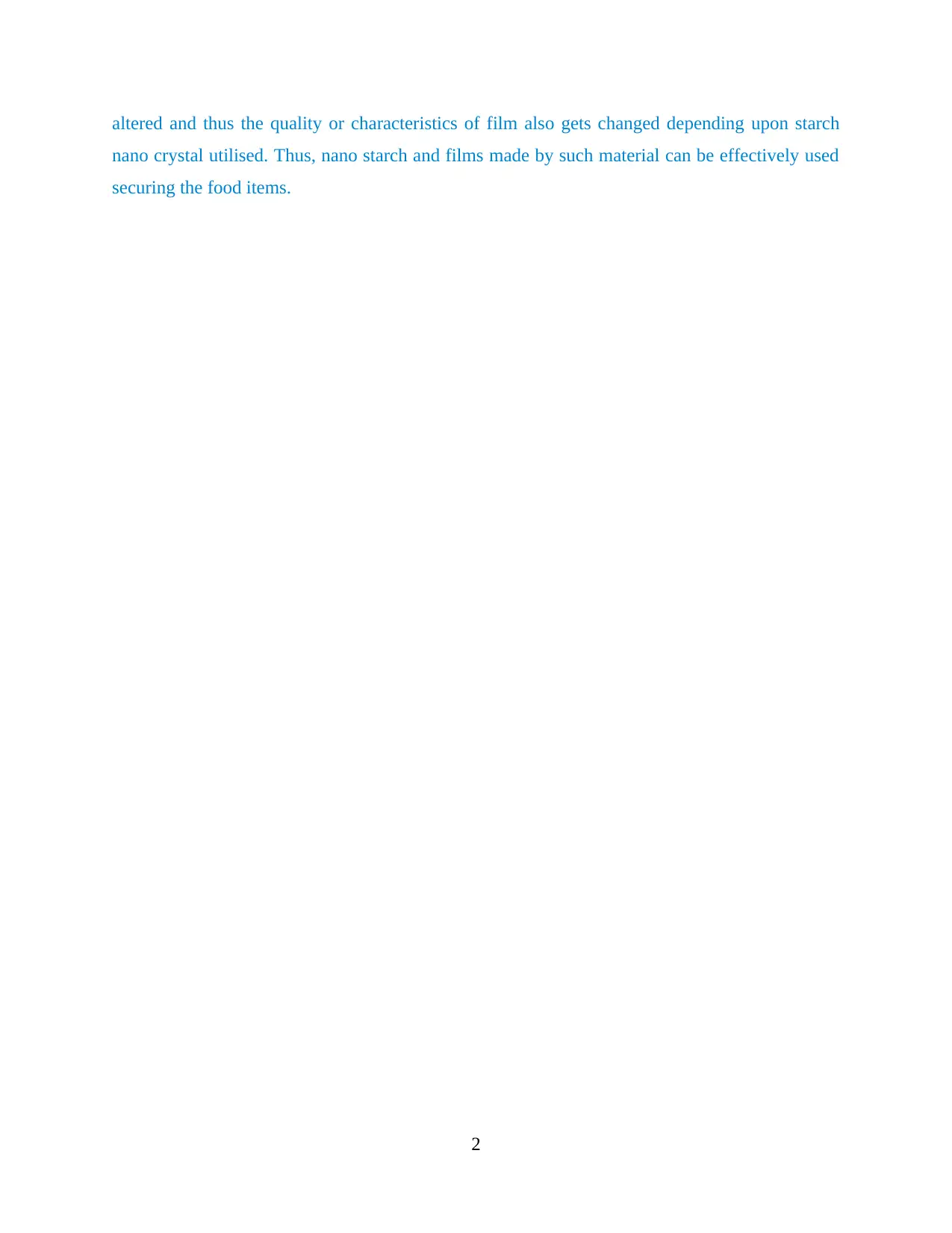
altered and thus the quality or characteristics of film also gets changed depending upon starch
nano crystal utilised. Thus, nano starch and films made by such material can be effectively used
securing the food items.
2
nano crystal utilised. Thus, nano starch and films made by such material can be effectively used
securing the food items.
2
⊘ This is a preview!⊘
Do you want full access?
Subscribe today to unlock all pages.

Trusted by 1+ million students worldwide
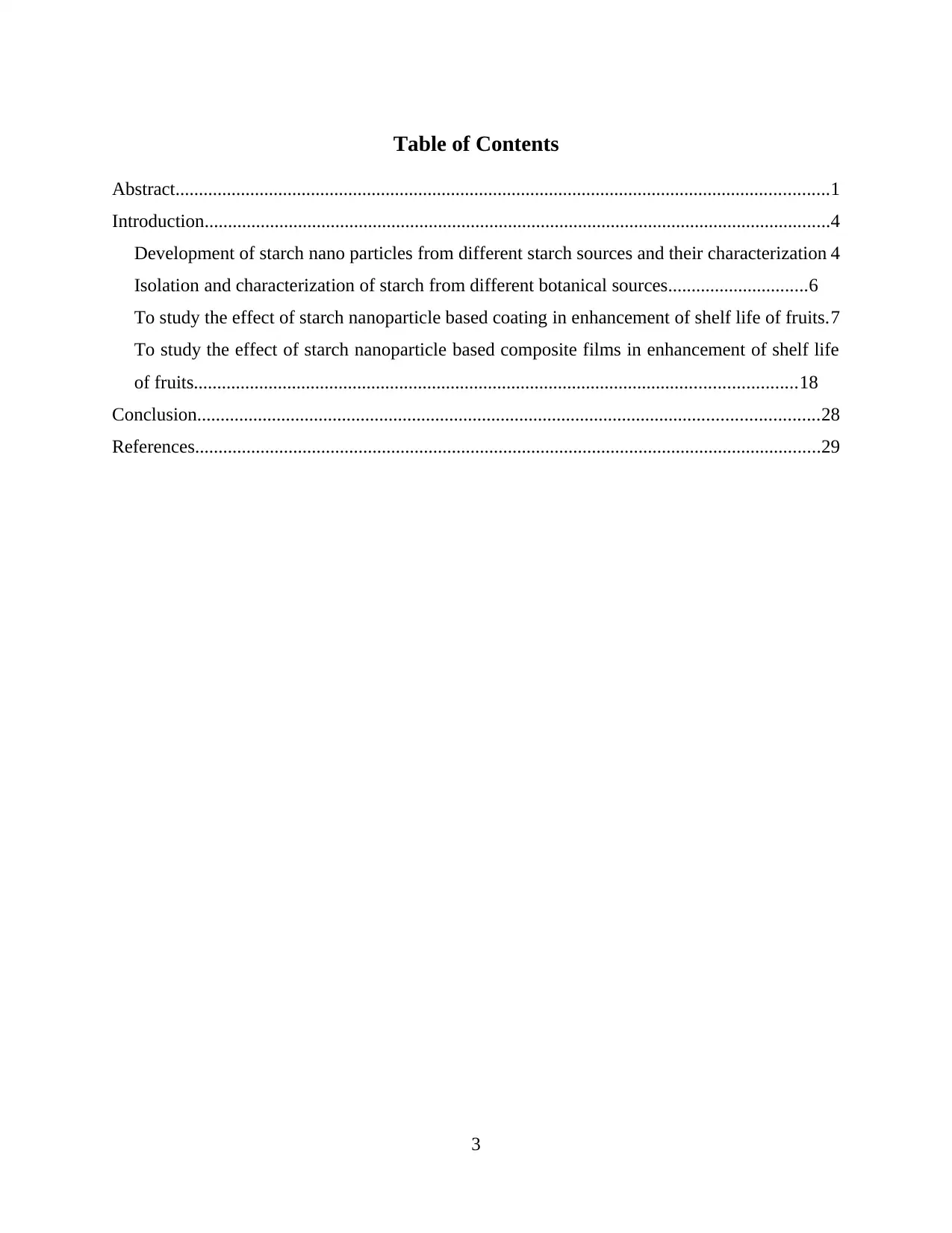
Table of Contents
Abstract............................................................................................................................................1
Introduction......................................................................................................................................4
Development of starch nano particles from different starch sources and their characterization 4
Isolation and characterization of starch from different botanical sources..............................6
To study the effect of starch nanoparticle based coating in enhancement of shelf life of fruits.7
To study the effect of starch nanoparticle based composite films in enhancement of shelf life
of fruits.................................................................................................................................18
Conclusion.....................................................................................................................................28
References......................................................................................................................................29
3
Abstract............................................................................................................................................1
Introduction......................................................................................................................................4
Development of starch nano particles from different starch sources and their characterization 4
Isolation and characterization of starch from different botanical sources..............................6
To study the effect of starch nanoparticle based coating in enhancement of shelf life of fruits.7
To study the effect of starch nanoparticle based composite films in enhancement of shelf life
of fruits.................................................................................................................................18
Conclusion.....................................................................................................................................28
References......................................................................................................................................29
3
Paraphrase This Document
Need a fresh take? Get an instant paraphrase of this document with our AI Paraphraser
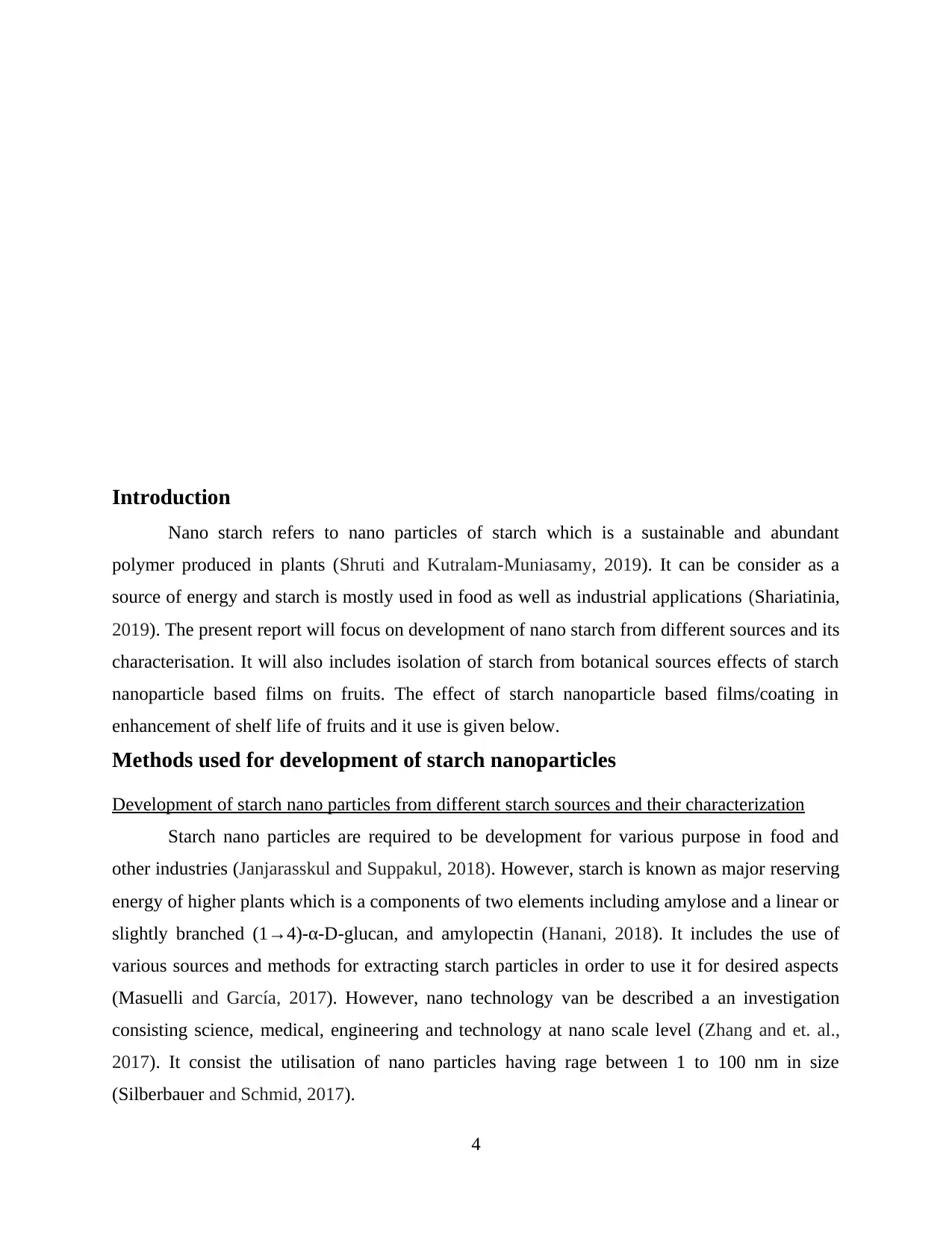
Introduction
Nano starch refers to nano particles of starch which is a sustainable and abundant
polymer produced in plants (Shruti and Kutralam-Muniasamy, 2019). It can be consider as a
source of energy and starch is mostly used in food as well as industrial applications (Shariatinia,
2019). The present report will focus on development of nano starch from different sources and its
characterisation. It will also includes isolation of starch from botanical sources effects of starch
nanoparticle based films on fruits. The effect of starch nanoparticle based films/coating in
enhancement of shelf life of fruits and it use is given below.
Methods used for development of starch nanoparticles
Development of starch nano particles from different starch sources and their characterization
Starch nano particles are required to be development for various purpose in food and
other industries (Janjarasskul and Suppakul, 2018). However, starch is known as major reserving
energy of higher plants which is a components of two elements including amylose and a linear or
slightly branched (1→4)-α-D-glucan, and amylopectin (Hanani, 2018). It includes the use of
various sources and methods for extracting starch particles in order to use it for desired aspects
(Masuelli and García, 2017). However, nano technology van be described a an investigation
consisting science, medical, engineering and technology at nano scale level (Zhang and et. al.,
2017). It consist the utilisation of nano particles having rage between 1 to 100 nm in size
(Silberbauer and Schmid, 2017).
4
Nano starch refers to nano particles of starch which is a sustainable and abundant
polymer produced in plants (Shruti and Kutralam-Muniasamy, 2019). It can be consider as a
source of energy and starch is mostly used in food as well as industrial applications (Shariatinia,
2019). The present report will focus on development of nano starch from different sources and its
characterisation. It will also includes isolation of starch from botanical sources effects of starch
nanoparticle based films on fruits. The effect of starch nanoparticle based films/coating in
enhancement of shelf life of fruits and it use is given below.
Methods used for development of starch nanoparticles
Development of starch nano particles from different starch sources and their characterization
Starch nano particles are required to be development for various purpose in food and
other industries (Janjarasskul and Suppakul, 2018). However, starch is known as major reserving
energy of higher plants which is a components of two elements including amylose and a linear or
slightly branched (1→4)-α-D-glucan, and amylopectin (Hanani, 2018). It includes the use of
various sources and methods for extracting starch particles in order to use it for desired aspects
(Masuelli and García, 2017). However, nano technology van be described a an investigation
consisting science, medical, engineering and technology at nano scale level (Zhang and et. al.,
2017). It consist the utilisation of nano particles having rage between 1 to 100 nm in size
(Silberbauer and Schmid, 2017).
4
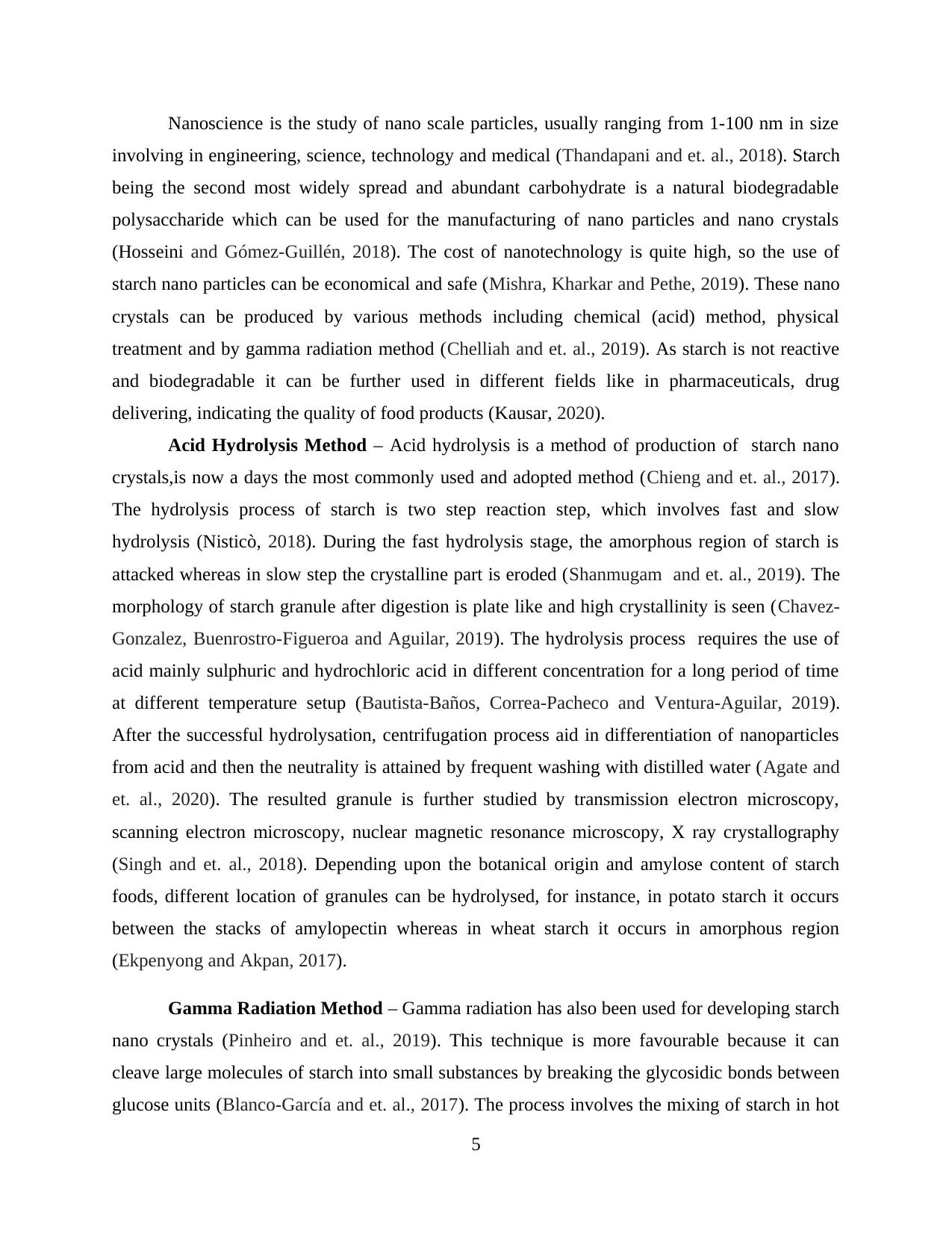
Nanoscience is the study of nano scale particles, usually ranging from 1-100 nm in size
involving in engineering, science, technology and medical (Thandapani and et. al., 2018). Starch
being the second most widely spread and abundant carbohydrate is a natural biodegradable
polysaccharide which can be used for the manufacturing of nano particles and nano crystals
(Hosseini and Gómez-Guillén, 2018). The cost of nanotechnology is quite high, so the use of
starch nano particles can be economical and safe (Mishra, Kharkar and Pethe, 2019). These nano
crystals can be produced by various methods including chemical (acid) method, physical
treatment and by gamma radiation method (Chelliah and et. al., 2019). As starch is not reactive
and biodegradable it can be further used in different fields like in pharmaceuticals, drug
delivering, indicating the quality of food products (Kausar, 2020).
Acid Hydrolysis Method – Acid hydrolysis is a method of production of starch nano
crystals,is now a days the most commonly used and adopted method (Chieng and et. al., 2017).
The hydrolysis process of starch is two step reaction step, which involves fast and slow
hydrolysis (Nisticò, 2018). During the fast hydrolysis stage, the amorphous region of starch is
attacked whereas in slow step the crystalline part is eroded (Shanmugam and et. al., 2019). The
morphology of starch granule after digestion is plate like and high crystallinity is seen (Chavez-
Gonzalez, Buenrostro-Figueroa and Aguilar, 2019). The hydrolysis process requires the use of
acid mainly sulphuric and hydrochloric acid in different concentration for a long period of time
at different temperature setup (Bautista‐Baños, Correa‐Pacheco and Ventura‐Aguilar, 2019).
After the successful hydrolysation, centrifugation process aid in differentiation of nanoparticles
from acid and then the neutrality is attained by frequent washing with distilled water (Agate and
et. al., 2020). The resulted granule is further studied by transmission electron microscopy,
scanning electron microscopy, nuclear magnetic resonance microscopy, X ray crystallography
(Singh and et. al., 2018). Depending upon the botanical origin and amylose content of starch
foods, different location of granules can be hydrolysed, for instance, in potato starch it occurs
between the stacks of amylopectin whereas in wheat starch it occurs in amorphous region
(Ekpenyong and Akpan, 2017).
Gamma Radiation Method – Gamma radiation has also been used for developing starch
nano crystals (Pinheiro and et. al., 2019). This technique is more favourable because it can
cleave large molecules of starch into small substances by breaking the glycosidic bonds between
glucose units (Blanco-García and et. al., 2017). The process involves the mixing of starch in hot
5
involving in engineering, science, technology and medical (Thandapani and et. al., 2018). Starch
being the second most widely spread and abundant carbohydrate is a natural biodegradable
polysaccharide which can be used for the manufacturing of nano particles and nano crystals
(Hosseini and Gómez-Guillén, 2018). The cost of nanotechnology is quite high, so the use of
starch nano particles can be economical and safe (Mishra, Kharkar and Pethe, 2019). These nano
crystals can be produced by various methods including chemical (acid) method, physical
treatment and by gamma radiation method (Chelliah and et. al., 2019). As starch is not reactive
and biodegradable it can be further used in different fields like in pharmaceuticals, drug
delivering, indicating the quality of food products (Kausar, 2020).
Acid Hydrolysis Method – Acid hydrolysis is a method of production of starch nano
crystals,is now a days the most commonly used and adopted method (Chieng and et. al., 2017).
The hydrolysis process of starch is two step reaction step, which involves fast and slow
hydrolysis (Nisticò, 2018). During the fast hydrolysis stage, the amorphous region of starch is
attacked whereas in slow step the crystalline part is eroded (Shanmugam and et. al., 2019). The
morphology of starch granule after digestion is plate like and high crystallinity is seen (Chavez-
Gonzalez, Buenrostro-Figueroa and Aguilar, 2019). The hydrolysis process requires the use of
acid mainly sulphuric and hydrochloric acid in different concentration for a long period of time
at different temperature setup (Bautista‐Baños, Correa‐Pacheco and Ventura‐Aguilar, 2019).
After the successful hydrolysation, centrifugation process aid in differentiation of nanoparticles
from acid and then the neutrality is attained by frequent washing with distilled water (Agate and
et. al., 2020). The resulted granule is further studied by transmission electron microscopy,
scanning electron microscopy, nuclear magnetic resonance microscopy, X ray crystallography
(Singh and et. al., 2018). Depending upon the botanical origin and amylose content of starch
foods, different location of granules can be hydrolysed, for instance, in potato starch it occurs
between the stacks of amylopectin whereas in wheat starch it occurs in amorphous region
(Ekpenyong and Akpan, 2017).
Gamma Radiation Method – Gamma radiation has also been used for developing starch
nano crystals (Pinheiro and et. al., 2019). This technique is more favourable because it can
cleave large molecules of starch into small substances by breaking the glycosidic bonds between
glucose units (Blanco-García and et. al., 2017). The process involves the mixing of starch in hot
5
⊘ This is a preview!⊘
Do you want full access?
Subscribe today to unlock all pages.

Trusted by 1+ million students worldwide
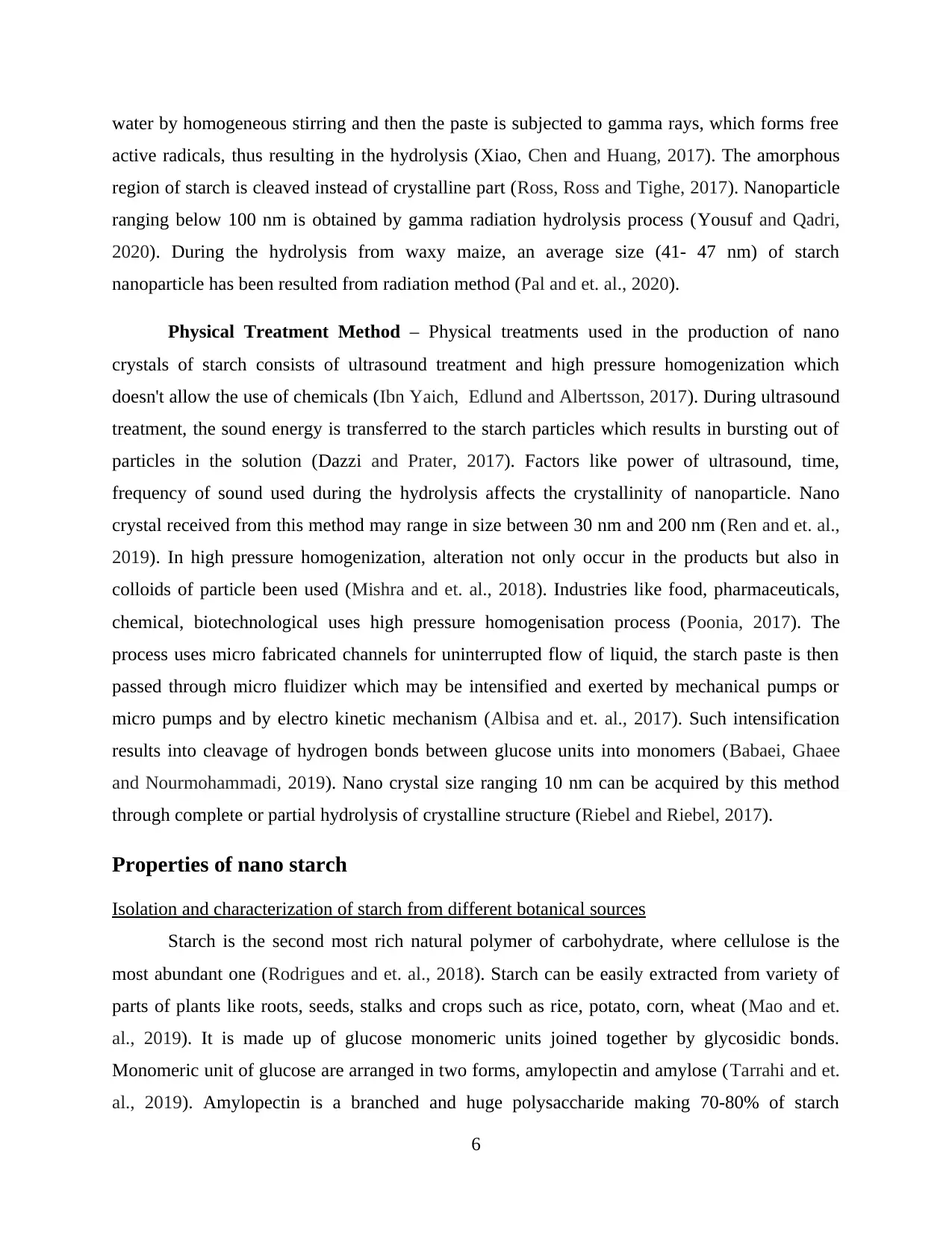
water by homogeneous stirring and then the paste is subjected to gamma rays, which forms free
active radicals, thus resulting in the hydrolysis (Xiao, Chen and Huang, 2017). The amorphous
region of starch is cleaved instead of crystalline part (Ross, Ross and Tighe, 2017). Nanoparticle
ranging below 100 nm is obtained by gamma radiation hydrolysis process (Yousuf and Qadri,
2020). During the hydrolysis from waxy maize, an average size (41- 47 nm) of starch
nanoparticle has been resulted from radiation method (Pal and et. al., 2020).
Physical Treatment Method – Physical treatments used in the production of nano
crystals of starch consists of ultrasound treatment and high pressure homogenization which
doesn't allow the use of chemicals (Ibn Yaich, Edlund and Albertsson, 2017). During ultrasound
treatment, the sound energy is transferred to the starch particles which results in bursting out of
particles in the solution (Dazzi and Prater, 2017). Factors like power of ultrasound, time,
frequency of sound used during the hydrolysis affects the crystallinity of nanoparticle. Nano
crystal received from this method may range in size between 30 nm and 200 nm (Ren and et. al.,
2019). In high pressure homogenization, alteration not only occur in the products but also in
colloids of particle been used (Mishra and et. al., 2018). Industries like food, pharmaceuticals,
chemical, biotechnological uses high pressure homogenisation process (Poonia, 2017). The
process uses micro fabricated channels for uninterrupted flow of liquid, the starch paste is then
passed through micro fluidizer which may be intensified and exerted by mechanical pumps or
micro pumps and by electro kinetic mechanism (Albisa and et. al., 2017). Such intensification
results into cleavage of hydrogen bonds between glucose units into monomers (Babaei, Ghaee
and Nourmohammadi, 2019). Nano crystal size ranging 10 nm can be acquired by this method
through complete or partial hydrolysis of crystalline structure (Riebel and Riebel, 2017).
Properties of nano starch
Isolation and characterization of starch from different botanical sources
Starch is the second most rich natural polymer of carbohydrate, where cellulose is the
most abundant one (Rodrigues and et. al., 2018). Starch can be easily extracted from variety of
parts of plants like roots, seeds, stalks and crops such as rice, potato, corn, wheat (Mao and et.
al., 2019). It is made up of glucose monomeric units joined together by glycosidic bonds.
Monomeric unit of glucose are arranged in two forms, amylopectin and amylose (Tarrahi and et.
al., 2019). Amylopectin is a branched and huge polysaccharide making 70-80% of starch
6
active radicals, thus resulting in the hydrolysis (Xiao, Chen and Huang, 2017). The amorphous
region of starch is cleaved instead of crystalline part (Ross, Ross and Tighe, 2017). Nanoparticle
ranging below 100 nm is obtained by gamma radiation hydrolysis process (Yousuf and Qadri,
2020). During the hydrolysis from waxy maize, an average size (41- 47 nm) of starch
nanoparticle has been resulted from radiation method (Pal and et. al., 2020).
Physical Treatment Method – Physical treatments used in the production of nano
crystals of starch consists of ultrasound treatment and high pressure homogenization which
doesn't allow the use of chemicals (Ibn Yaich, Edlund and Albertsson, 2017). During ultrasound
treatment, the sound energy is transferred to the starch particles which results in bursting out of
particles in the solution (Dazzi and Prater, 2017). Factors like power of ultrasound, time,
frequency of sound used during the hydrolysis affects the crystallinity of nanoparticle. Nano
crystal received from this method may range in size between 30 nm and 200 nm (Ren and et. al.,
2019). In high pressure homogenization, alteration not only occur in the products but also in
colloids of particle been used (Mishra and et. al., 2018). Industries like food, pharmaceuticals,
chemical, biotechnological uses high pressure homogenisation process (Poonia, 2017). The
process uses micro fabricated channels for uninterrupted flow of liquid, the starch paste is then
passed through micro fluidizer which may be intensified and exerted by mechanical pumps or
micro pumps and by electro kinetic mechanism (Albisa and et. al., 2017). Such intensification
results into cleavage of hydrogen bonds between glucose units into monomers (Babaei, Ghaee
and Nourmohammadi, 2019). Nano crystal size ranging 10 nm can be acquired by this method
through complete or partial hydrolysis of crystalline structure (Riebel and Riebel, 2017).
Properties of nano starch
Isolation and characterization of starch from different botanical sources
Starch is the second most rich natural polymer of carbohydrate, where cellulose is the
most abundant one (Rodrigues and et. al., 2018). Starch can be easily extracted from variety of
parts of plants like roots, seeds, stalks and crops such as rice, potato, corn, wheat (Mao and et.
al., 2019). It is made up of glucose monomeric units joined together by glycosidic bonds.
Monomeric unit of glucose are arranged in two forms, amylopectin and amylose (Tarrahi and et.
al., 2019). Amylopectin is a branched and huge polysaccharide making 70-80% of starch
6
Paraphrase This Document
Need a fresh take? Get an instant paraphrase of this document with our AI Paraphraser
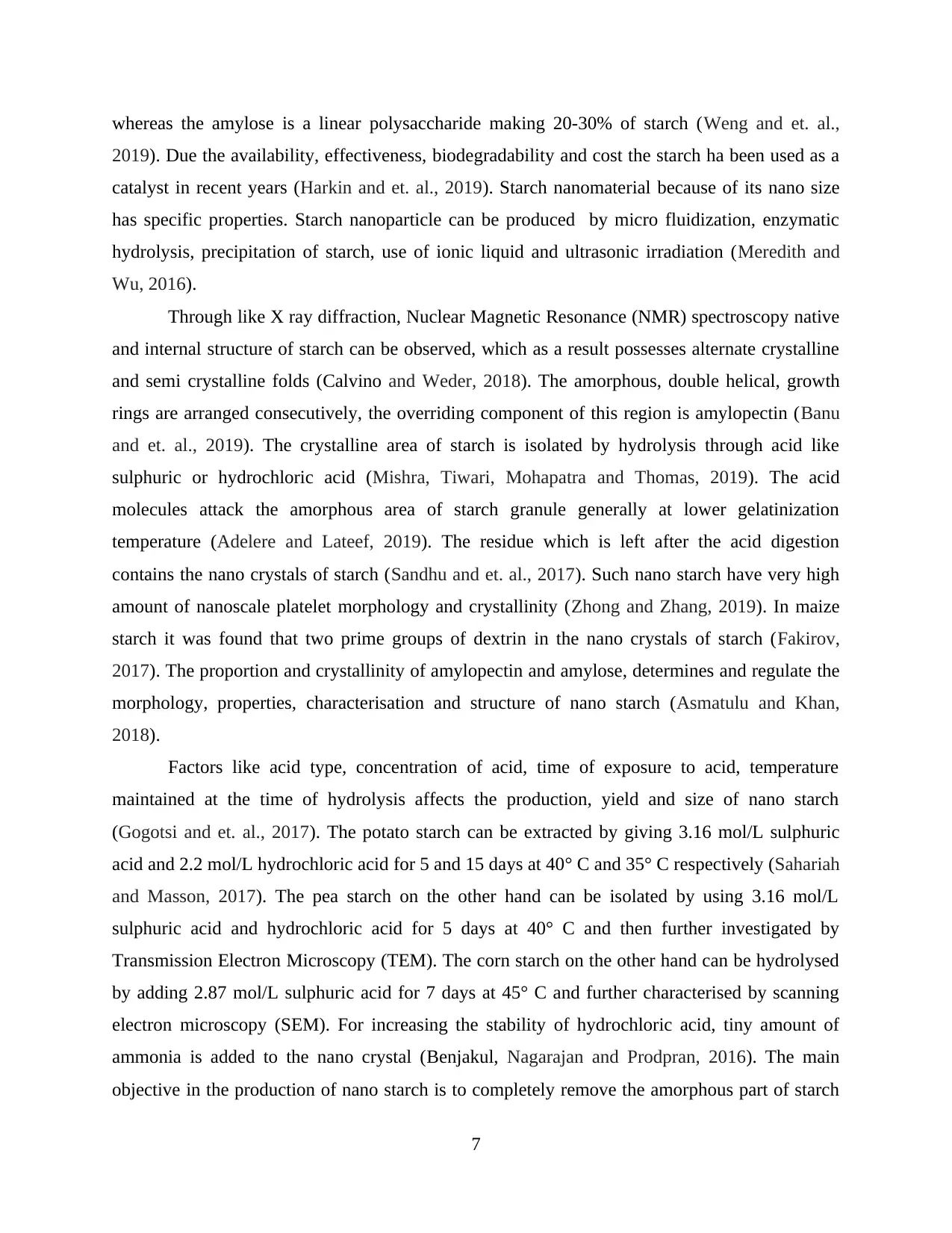
whereas the amylose is a linear polysaccharide making 20-30% of starch (Weng and et. al.,
2019). Due the availability, effectiveness, biodegradability and cost the starch ha been used as a
catalyst in recent years (Harkin and et. al., 2019). Starch nanomaterial because of its nano size
has specific properties. Starch nanoparticle can be produced by micro fluidization, enzymatic
hydrolysis, precipitation of starch, use of ionic liquid and ultrasonic irradiation (Meredith and
Wu, 2016).
Through like X ray diffraction, Nuclear Magnetic Resonance (NMR) spectroscopy native
and internal structure of starch can be observed, which as a result possesses alternate crystalline
and semi crystalline folds (Calvino and Weder, 2018). The amorphous, double helical, growth
rings are arranged consecutively, the overriding component of this region is amylopectin (Banu
and et. al., 2019). The crystalline area of starch is isolated by hydrolysis through acid like
sulphuric or hydrochloric acid (Mishra, Tiwari, Mohapatra and Thomas, 2019). The acid
molecules attack the amorphous area of starch granule generally at lower gelatinization
temperature (Adelere and Lateef, 2019). The residue which is left after the acid digestion
contains the nano crystals of starch (Sandhu and et. al., 2017). Such nano starch have very high
amount of nanoscale platelet morphology and crystallinity (Zhong and Zhang, 2019). In maize
starch it was found that two prime groups of dextrin in the nano crystals of starch (Fakirov,
2017). The proportion and crystallinity of amylopectin and amylose, determines and regulate the
morphology, properties, characterisation and structure of nano starch (Asmatulu and Khan,
2018).
Factors like acid type, concentration of acid, time of exposure to acid, temperature
maintained at the time of hydrolysis affects the production, yield and size of nano starch
(Gogotsi and et. al., 2017). The potato starch can be extracted by giving 3.16 mol/L sulphuric
acid and 2.2 mol/L hydrochloric acid for 5 and 15 days at 40° C and 35° C respectively (Sahariah
and Masson, 2017). The pea starch on the other hand can be isolated by using 3.16 mol/L
sulphuric acid and hydrochloric acid for 5 days at 40° C and then further investigated by
Transmission Electron Microscopy (TEM). The corn starch on the other hand can be hydrolysed
by adding 2.87 mol/L sulphuric acid for 7 days at 45° C and further characterised by scanning
electron microscopy (SEM). For increasing the stability of hydrochloric acid, tiny amount of
ammonia is added to the nano crystal (Benjakul, Nagarajan and Prodpran, 2016). The main
objective in the production of nano starch is to completely remove the amorphous part of starch
7
2019). Due the availability, effectiveness, biodegradability and cost the starch ha been used as a
catalyst in recent years (Harkin and et. al., 2019). Starch nanomaterial because of its nano size
has specific properties. Starch nanoparticle can be produced by micro fluidization, enzymatic
hydrolysis, precipitation of starch, use of ionic liquid and ultrasonic irradiation (Meredith and
Wu, 2016).
Through like X ray diffraction, Nuclear Magnetic Resonance (NMR) spectroscopy native
and internal structure of starch can be observed, which as a result possesses alternate crystalline
and semi crystalline folds (Calvino and Weder, 2018). The amorphous, double helical, growth
rings are arranged consecutively, the overriding component of this region is amylopectin (Banu
and et. al., 2019). The crystalline area of starch is isolated by hydrolysis through acid like
sulphuric or hydrochloric acid (Mishra, Tiwari, Mohapatra and Thomas, 2019). The acid
molecules attack the amorphous area of starch granule generally at lower gelatinization
temperature (Adelere and Lateef, 2019). The residue which is left after the acid digestion
contains the nano crystals of starch (Sandhu and et. al., 2017). Such nano starch have very high
amount of nanoscale platelet morphology and crystallinity (Zhong and Zhang, 2019). In maize
starch it was found that two prime groups of dextrin in the nano crystals of starch (Fakirov,
2017). The proportion and crystallinity of amylopectin and amylose, determines and regulate the
morphology, properties, characterisation and structure of nano starch (Asmatulu and Khan,
2018).
Factors like acid type, concentration of acid, time of exposure to acid, temperature
maintained at the time of hydrolysis affects the production, yield and size of nano starch
(Gogotsi and et. al., 2017). The potato starch can be extracted by giving 3.16 mol/L sulphuric
acid and 2.2 mol/L hydrochloric acid for 5 and 15 days at 40° C and 35° C respectively (Sahariah
and Masson, 2017). The pea starch on the other hand can be isolated by using 3.16 mol/L
sulphuric acid and hydrochloric acid for 5 days at 40° C and then further investigated by
Transmission Electron Microscopy (TEM). The corn starch on the other hand can be hydrolysed
by adding 2.87 mol/L sulphuric acid for 7 days at 45° C and further characterised by scanning
electron microscopy (SEM). For increasing the stability of hydrochloric acid, tiny amount of
ammonia is added to the nano crystal (Benjakul, Nagarajan and Prodpran, 2016). The main
objective in the production of nano starch is to completely remove the amorphous part of starch
7
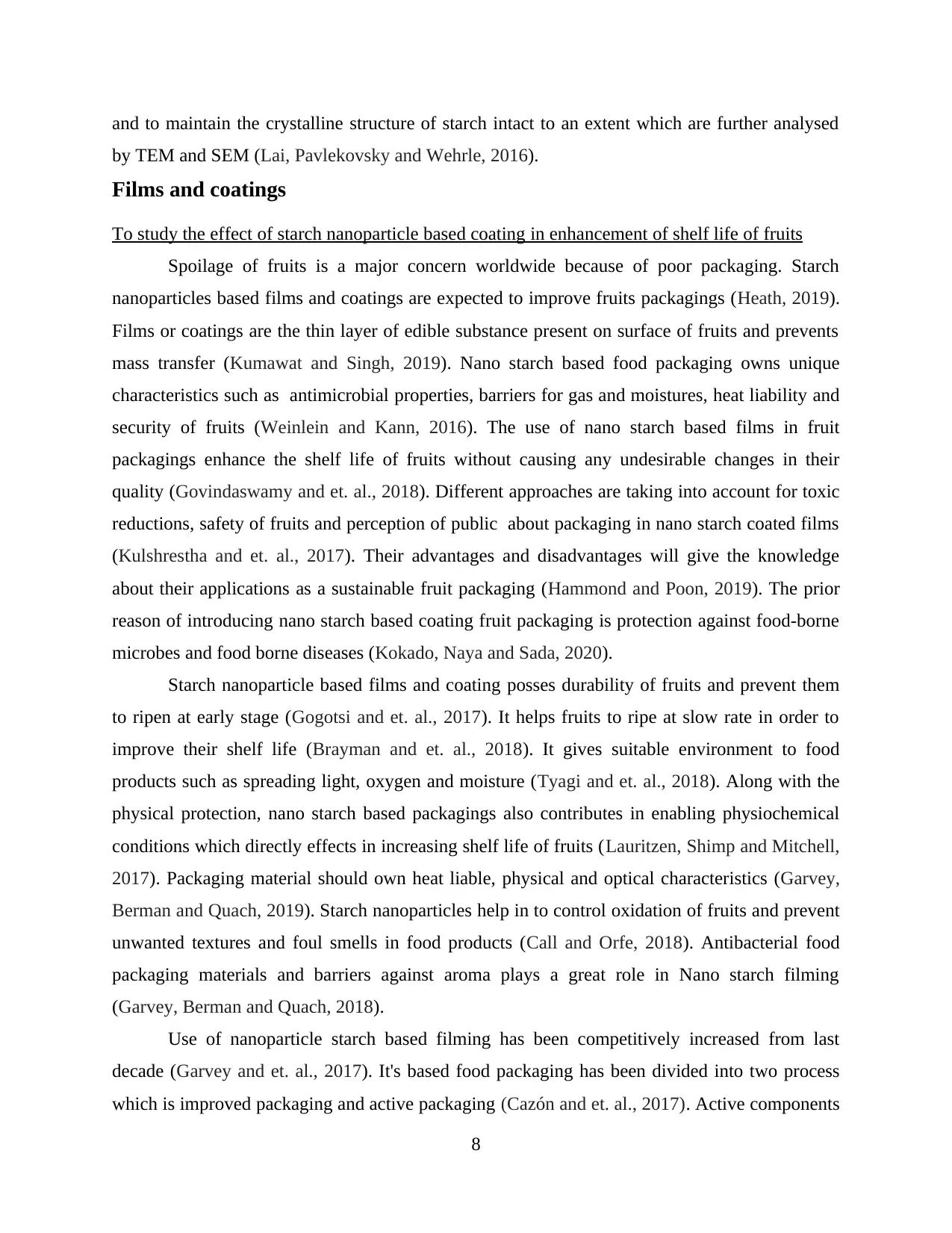
and to maintain the crystalline structure of starch intact to an extent which are further analysed
by TEM and SEM (Lai, Pavlekovsky and Wehrle, 2016).
Films and coatings
To study the effect of starch nanoparticle based coating in enhancement of shelf life of fruits
Spoilage of fruits is a major concern worldwide because of poor packaging. Starch
nanoparticles based films and coatings are expected to improve fruits packagings (Heath, 2019).
Films or coatings are the thin layer of edible substance present on surface of fruits and prevents
mass transfer (Kumawat and Singh, 2019). Nano starch based food packaging owns unique
characteristics such as antimicrobial properties, barriers for gas and moistures, heat liability and
security of fruits (Weinlein and Kann, 2016). The use of nano starch based films in fruit
packagings enhance the shelf life of fruits without causing any undesirable changes in their
quality (Govindaswamy and et. al., 2018). Different approaches are taking into account for toxic
reductions, safety of fruits and perception of public about packaging in nano starch coated films
(Kulshrestha and et. al., 2017). Their advantages and disadvantages will give the knowledge
about their applications as a sustainable fruit packaging (Hammond and Poon, 2019). The prior
reason of introducing nano starch based coating fruit packaging is protection against food-borne
microbes and food borne diseases (Kokado, Naya and Sada, 2020).
Starch nanoparticle based films and coating posses durability of fruits and prevent them
to ripen at early stage (Gogotsi and et. al., 2017). It helps fruits to ripe at slow rate in order to
improve their shelf life (Brayman and et. al., 2018). It gives suitable environment to food
products such as spreading light, oxygen and moisture (Tyagi and et. al., 2018). Along with the
physical protection, nano starch based packagings also contributes in enabling physiochemical
conditions which directly effects in increasing shelf life of fruits (Lauritzen, Shimp and Mitchell,
2017). Packaging material should own heat liable, physical and optical characteristics (Garvey,
Berman and Quach, 2019). Starch nanoparticles help in to control oxidation of fruits and prevent
unwanted textures and foul smells in food products (Call and Orfe, 2018). Antibacterial food
packaging materials and barriers against aroma plays a great role in Nano starch filming
(Garvey, Berman and Quach, 2018).
Use of nanoparticle starch based filming has been competitively increased from last
decade (Garvey and et. al., 2017). It's based food packaging has been divided into two process
which is improved packaging and active packaging (Cazón and et. al., 2017). Active components
8
by TEM and SEM (Lai, Pavlekovsky and Wehrle, 2016).
Films and coatings
To study the effect of starch nanoparticle based coating in enhancement of shelf life of fruits
Spoilage of fruits is a major concern worldwide because of poor packaging. Starch
nanoparticles based films and coatings are expected to improve fruits packagings (Heath, 2019).
Films or coatings are the thin layer of edible substance present on surface of fruits and prevents
mass transfer (Kumawat and Singh, 2019). Nano starch based food packaging owns unique
characteristics such as antimicrobial properties, barriers for gas and moistures, heat liability and
security of fruits (Weinlein and Kann, 2016). The use of nano starch based films in fruit
packagings enhance the shelf life of fruits without causing any undesirable changes in their
quality (Govindaswamy and et. al., 2018). Different approaches are taking into account for toxic
reductions, safety of fruits and perception of public about packaging in nano starch coated films
(Kulshrestha and et. al., 2017). Their advantages and disadvantages will give the knowledge
about their applications as a sustainable fruit packaging (Hammond and Poon, 2019). The prior
reason of introducing nano starch based coating fruit packaging is protection against food-borne
microbes and food borne diseases (Kokado, Naya and Sada, 2020).
Starch nanoparticle based films and coating posses durability of fruits and prevent them
to ripen at early stage (Gogotsi and et. al., 2017). It helps fruits to ripe at slow rate in order to
improve their shelf life (Brayman and et. al., 2018). It gives suitable environment to food
products such as spreading light, oxygen and moisture (Tyagi and et. al., 2018). Along with the
physical protection, nano starch based packagings also contributes in enabling physiochemical
conditions which directly effects in increasing shelf life of fruits (Lauritzen, Shimp and Mitchell,
2017). Packaging material should own heat liable, physical and optical characteristics (Garvey,
Berman and Quach, 2019). Starch nanoparticles help in to control oxidation of fruits and prevent
unwanted textures and foul smells in food products (Call and Orfe, 2018). Antibacterial food
packaging materials and barriers against aroma plays a great role in Nano starch filming
(Garvey, Berman and Quach, 2018).
Use of nanoparticle starch based filming has been competitively increased from last
decade (Garvey and et. al., 2017). It's based food packaging has been divided into two process
which is improved packaging and active packaging (Cazón and et. al., 2017). Active components
8
⊘ This is a preview!⊘
Do you want full access?
Subscribe today to unlock all pages.

Trusted by 1+ million students worldwide
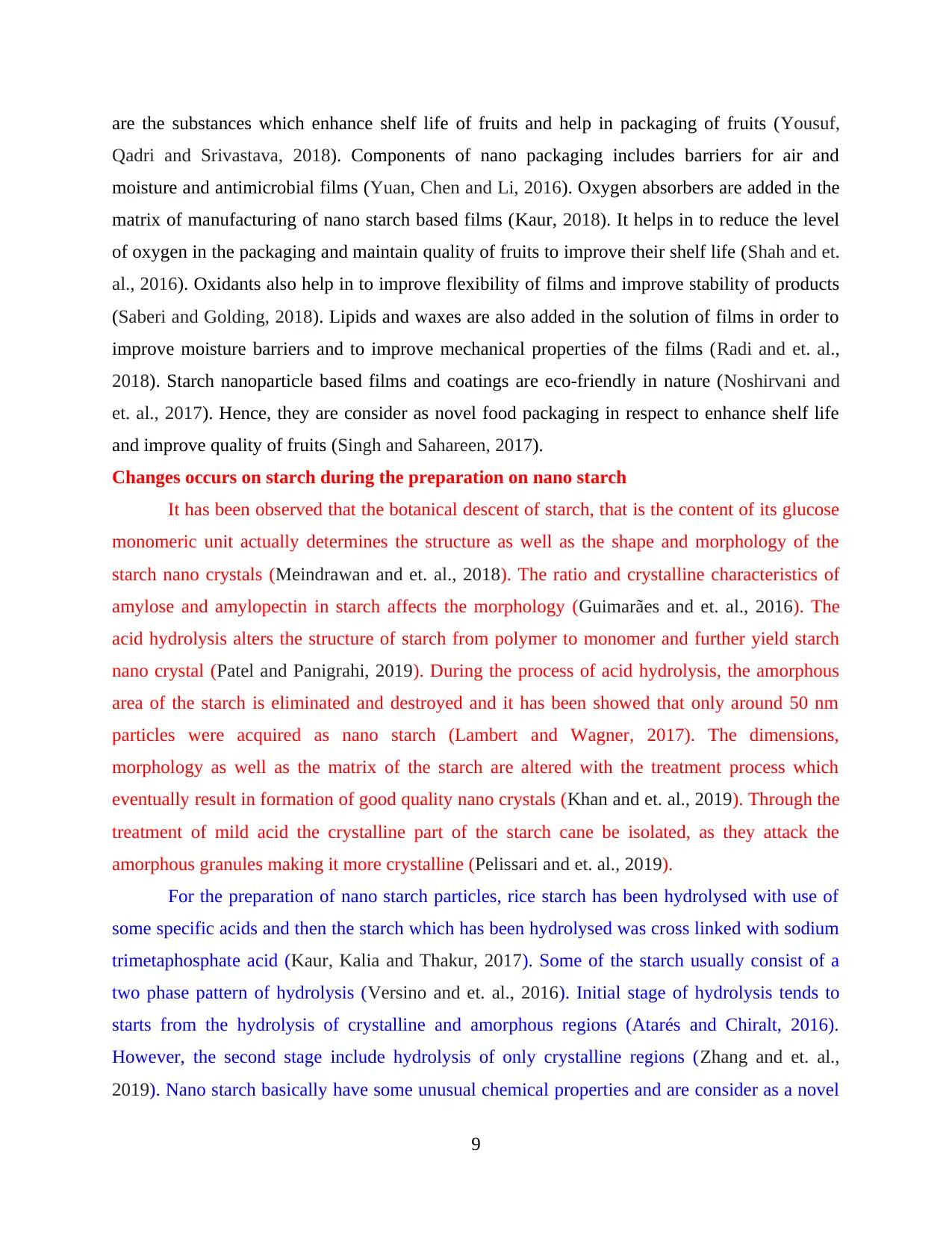
are the substances which enhance shelf life of fruits and help in packaging of fruits (Yousuf,
Qadri and Srivastava, 2018). Components of nano packaging includes barriers for air and
moisture and antimicrobial films (Yuan, Chen and Li, 2016). Oxygen absorbers are added in the
matrix of manufacturing of nano starch based films (Kaur, 2018). It helps in to reduce the level
of oxygen in the packaging and maintain quality of fruits to improve their shelf life (Shah and et.
al., 2016). Oxidants also help in to improve flexibility of films and improve stability of products
(Saberi and Golding, 2018). Lipids and waxes are also added in the solution of films in order to
improve moisture barriers and to improve mechanical properties of the films (Radi and et. al.,
2018). Starch nanoparticle based films and coatings are eco-friendly in nature (Noshirvani and
et. al., 2017). Hence, they are consider as novel food packaging in respect to enhance shelf life
and improve quality of fruits (Singh and Sahareen, 2017).
Changes occurs on starch during the preparation on nano starch
It has been observed that the botanical descent of starch, that is the content of its glucose
monomeric unit actually determines the structure as well as the shape and morphology of the
starch nano crystals (Meindrawan and et. al., 2018). The ratio and crystalline characteristics of
amylose and amylopectin in starch affects the morphology (Guimarães and et. al., 2016). The
acid hydrolysis alters the structure of starch from polymer to monomer and further yield starch
nano crystal (Patel and Panigrahi, 2019). During the process of acid hydrolysis, the amorphous
area of the starch is eliminated and destroyed and it has been showed that only around 50 nm
particles were acquired as nano starch (Lambert and Wagner, 2017). The dimensions,
morphology as well as the matrix of the starch are altered with the treatment process which
eventually result in formation of good quality nano crystals (Khan and et. al., 2019). Through the
treatment of mild acid the crystalline part of the starch cane be isolated, as they attack the
amorphous granules making it more crystalline (Pelissari and et. al., 2019).
For the preparation of nano starch particles, rice starch has been hydrolysed with use of
some specific acids and then the starch which has been hydrolysed was cross linked with sodium
trimetaphosphate acid (Kaur, Kalia and Thakur, 2017). Some of the starch usually consist of a
two phase pattern of hydrolysis (Versino and et. al., 2016). Initial stage of hydrolysis tends to
starts from the hydrolysis of crystalline and amorphous regions (Atarés and Chiralt, 2016).
However, the second stage include hydrolysis of only crystalline regions (Zhang and et. al.,
2019). Nano starch basically have some unusual chemical properties and are consider as a novel
9
Qadri and Srivastava, 2018). Components of nano packaging includes barriers for air and
moisture and antimicrobial films (Yuan, Chen and Li, 2016). Oxygen absorbers are added in the
matrix of manufacturing of nano starch based films (Kaur, 2018). It helps in to reduce the level
of oxygen in the packaging and maintain quality of fruits to improve their shelf life (Shah and et.
al., 2016). Oxidants also help in to improve flexibility of films and improve stability of products
(Saberi and Golding, 2018). Lipids and waxes are also added in the solution of films in order to
improve moisture barriers and to improve mechanical properties of the films (Radi and et. al.,
2018). Starch nanoparticle based films and coatings are eco-friendly in nature (Noshirvani and
et. al., 2017). Hence, they are consider as novel food packaging in respect to enhance shelf life
and improve quality of fruits (Singh and Sahareen, 2017).
Changes occurs on starch during the preparation on nano starch
It has been observed that the botanical descent of starch, that is the content of its glucose
monomeric unit actually determines the structure as well as the shape and morphology of the
starch nano crystals (Meindrawan and et. al., 2018). The ratio and crystalline characteristics of
amylose and amylopectin in starch affects the morphology (Guimarães and et. al., 2016). The
acid hydrolysis alters the structure of starch from polymer to monomer and further yield starch
nano crystal (Patel and Panigrahi, 2019). During the process of acid hydrolysis, the amorphous
area of the starch is eliminated and destroyed and it has been showed that only around 50 nm
particles were acquired as nano starch (Lambert and Wagner, 2017). The dimensions,
morphology as well as the matrix of the starch are altered with the treatment process which
eventually result in formation of good quality nano crystals (Khan and et. al., 2019). Through the
treatment of mild acid the crystalline part of the starch cane be isolated, as they attack the
amorphous granules making it more crystalline (Pelissari and et. al., 2019).
For the preparation of nano starch particles, rice starch has been hydrolysed with use of
some specific acids and then the starch which has been hydrolysed was cross linked with sodium
trimetaphosphate acid (Kaur, Kalia and Thakur, 2017). Some of the starch usually consist of a
two phase pattern of hydrolysis (Versino and et. al., 2016). Initial stage of hydrolysis tends to
starts from the hydrolysis of crystalline and amorphous regions (Atarés and Chiralt, 2016).
However, the second stage include hydrolysis of only crystalline regions (Zhang and et. al.,
2019). Nano starch basically have some unusual chemical properties and are consider as a novel
9
Paraphrase This Document
Need a fresh take? Get an instant paraphrase of this document with our AI Paraphraser
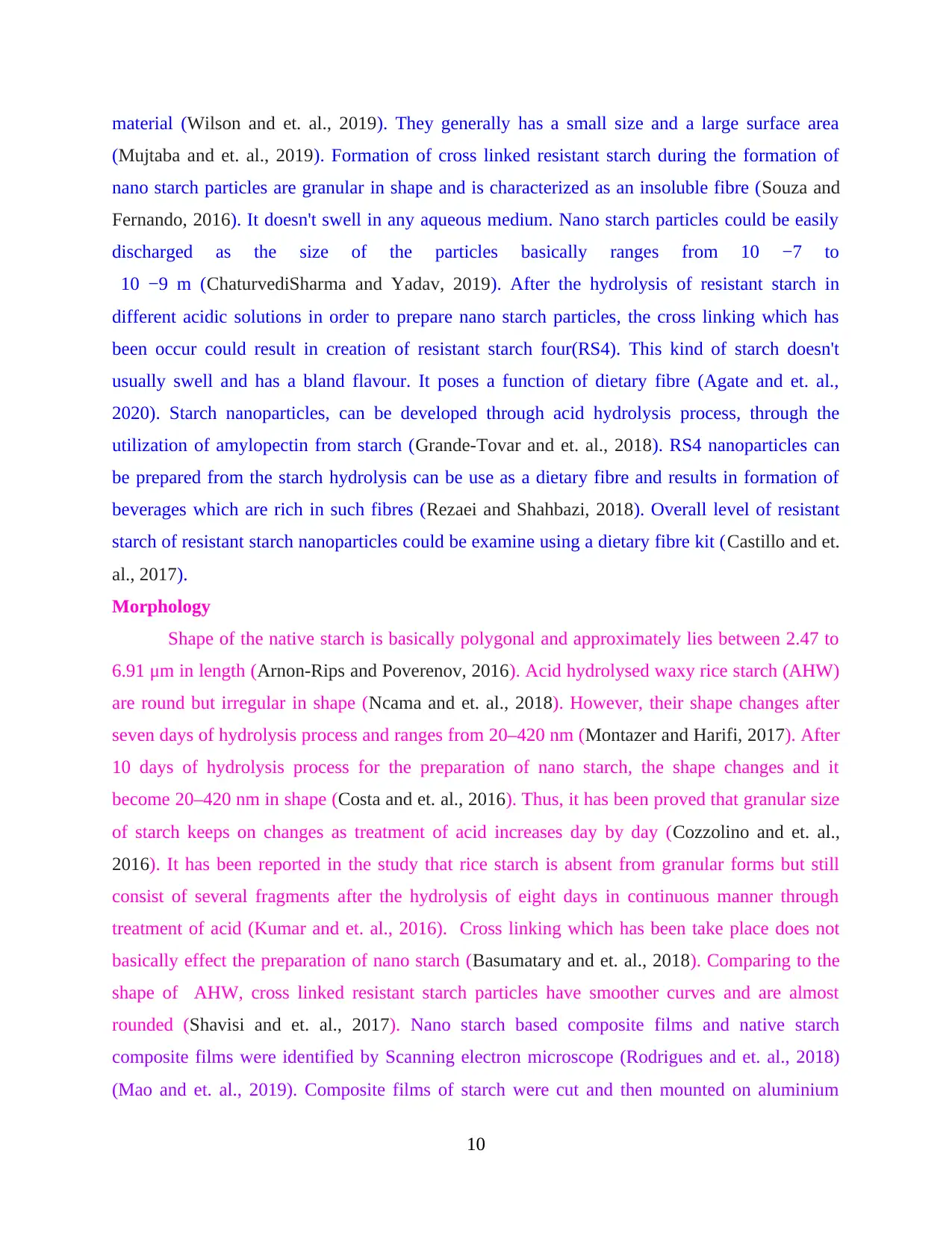
material (Wilson and et. al., 2019). They generally has a small size and a large surface area
(Mujtaba and et. al., 2019). Formation of cross linked resistant starch during the formation of
nano starch particles are granular in shape and is characterized as an insoluble fibre (Souza and
Fernando, 2016). It doesn't swell in any aqueous medium. Nano starch particles could be easily
discharged as the size of the particles basically ranges from 10 −7 to
10 −9 m (ChaturvediSharma and Yadav, 2019). After the hydrolysis of resistant starch in
different acidic solutions in order to prepare nano starch particles, the cross linking which has
been occur could result in creation of resistant starch four(RS4). This kind of starch doesn't
usually swell and has a bland flavour. It poses a function of dietary fibre (Agate and et. al.,
2020). Starch nanoparticles, can be developed through acid hydrolysis process, through the
utilization of amylopectin from starch (Grande-Tovar and et. al., 2018). RS4 nanoparticles can
be prepared from the starch hydrolysis can be use as a dietary fibre and results in formation of
beverages which are rich in such fibres (Rezaei and Shahbazi, 2018). Overall level of resistant
starch of resistant starch nanoparticles could be examine using a dietary fibre kit (Castillo and et.
al., 2017).
Morphology
Shape of the native starch is basically polygonal and approximately lies between 2.47 to
6.91 μm in length (Arnon-Rips and Poverenov, 2016). Acid hydrolysed waxy rice starch (AHW)
are round but irregular in shape (Ncama and et. al., 2018). However, their shape changes after
seven days of hydrolysis process and ranges from 20–420 nm (Montazer and Harifi, 2017). After
10 days of hydrolysis process for the preparation of nano starch, the shape changes and it
become 20–420 nm in shape (Costa and et. al., 2016). Thus, it has been proved that granular size
of starch keeps on changes as treatment of acid increases day by day (Cozzolino and et. al.,
2016). It has been reported in the study that rice starch is absent from granular forms but still
consist of several fragments after the hydrolysis of eight days in continuous manner through
treatment of acid (Kumar and et. al., 2016). Cross linking which has been take place does not
basically effect the preparation of nano starch (Basumatary and et. al., 2018). Comparing to the
shape of AHW, cross linked resistant starch particles have smoother curves and are almost
rounded (Shavisi and et. al., 2017). Nano starch based composite films and native starch
composite films were identified by Scanning electron microscope (Rodrigues and et. al., 2018)
(Mao and et. al., 2019). Composite films of starch were cut and then mounted on aluminium
10
(Mujtaba and et. al., 2019). Formation of cross linked resistant starch during the formation of
nano starch particles are granular in shape and is characterized as an insoluble fibre (Souza and
Fernando, 2016). It doesn't swell in any aqueous medium. Nano starch particles could be easily
discharged as the size of the particles basically ranges from 10 −7 to
10 −9 m (ChaturvediSharma and Yadav, 2019). After the hydrolysis of resistant starch in
different acidic solutions in order to prepare nano starch particles, the cross linking which has
been occur could result in creation of resistant starch four(RS4). This kind of starch doesn't
usually swell and has a bland flavour. It poses a function of dietary fibre (Agate and et. al.,
2020). Starch nanoparticles, can be developed through acid hydrolysis process, through the
utilization of amylopectin from starch (Grande-Tovar and et. al., 2018). RS4 nanoparticles can
be prepared from the starch hydrolysis can be use as a dietary fibre and results in formation of
beverages which are rich in such fibres (Rezaei and Shahbazi, 2018). Overall level of resistant
starch of resistant starch nanoparticles could be examine using a dietary fibre kit (Castillo and et.
al., 2017).
Morphology
Shape of the native starch is basically polygonal and approximately lies between 2.47 to
6.91 μm in length (Arnon-Rips and Poverenov, 2016). Acid hydrolysed waxy rice starch (AHW)
are round but irregular in shape (Ncama and et. al., 2018). However, their shape changes after
seven days of hydrolysis process and ranges from 20–420 nm (Montazer and Harifi, 2017). After
10 days of hydrolysis process for the preparation of nano starch, the shape changes and it
become 20–420 nm in shape (Costa and et. al., 2016). Thus, it has been proved that granular size
of starch keeps on changes as treatment of acid increases day by day (Cozzolino and et. al.,
2016). It has been reported in the study that rice starch is absent from granular forms but still
consist of several fragments after the hydrolysis of eight days in continuous manner through
treatment of acid (Kumar and et. al., 2016). Cross linking which has been take place does not
basically effect the preparation of nano starch (Basumatary and et. al., 2018). Comparing to the
shape of AHW, cross linked resistant starch particles have smoother curves and are almost
rounded (Shavisi and et. al., 2017). Nano starch based composite films and native starch
composite films were identified by Scanning electron microscope (Rodrigues and et. al., 2018)
(Mao and et. al., 2019). Composite films of starch were cut and then mounted on aluminium
10
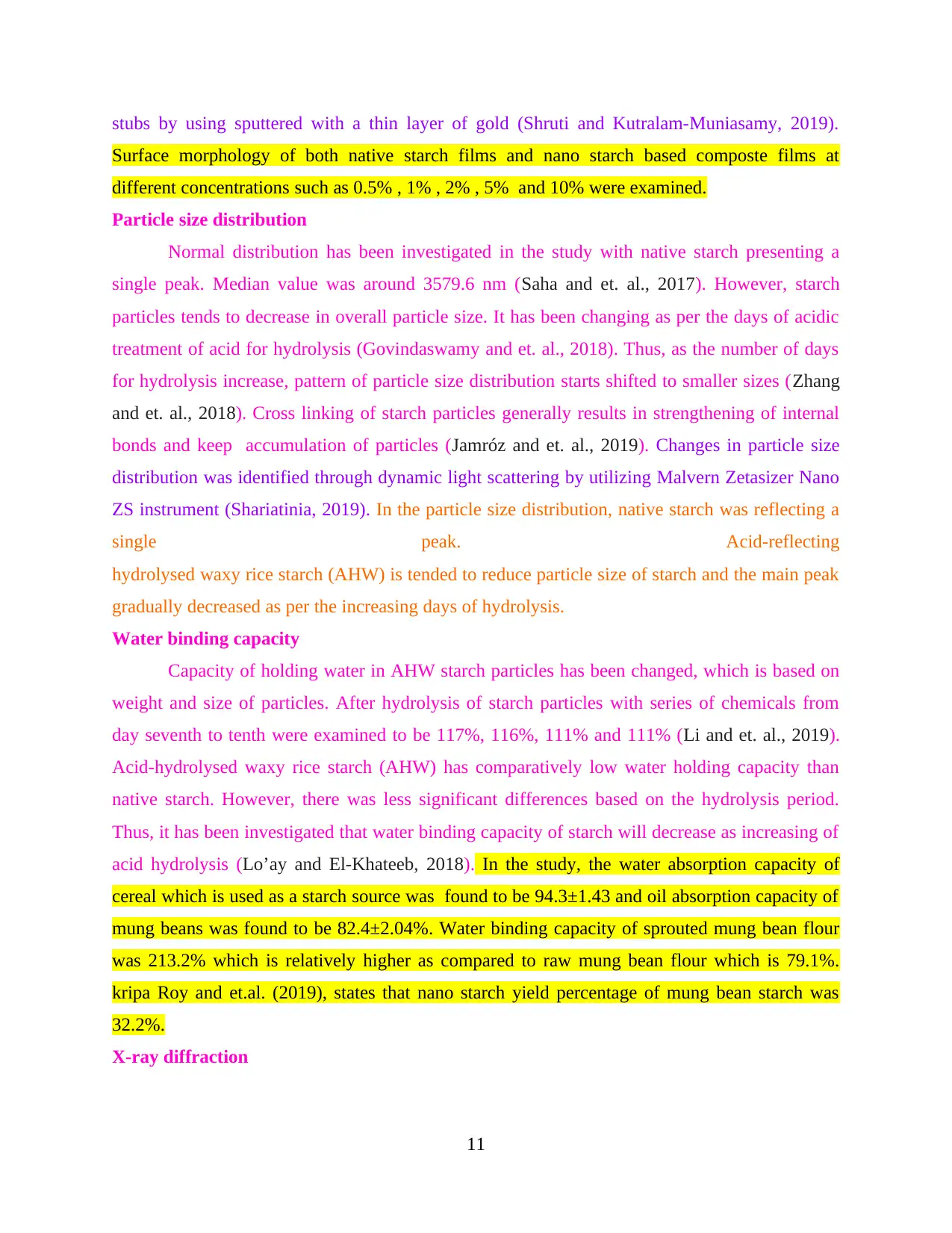
stubs by using sputtered with a thin layer of gold (Shruti and Kutralam-Muniasamy, 2019).
Surface morphology of both native starch films and nano starch based composte films at
different concentrations such as 0.5% , 1% , 2% , 5% and 10% were examined.
Particle size distribution
Normal distribution has been investigated in the study with native starch presenting a
single peak. Median value was around 3579.6 nm (Saha and et. al., 2017). However, starch
particles tends to decrease in overall particle size. It has been changing as per the days of acidic
treatment of acid for hydrolysis (Govindaswamy and et. al., 2018). Thus, as the number of days
for hydrolysis increase, pattern of particle size distribution starts shifted to smaller sizes (Zhang
and et. al., 2018). Cross linking of starch particles generally results in strengthening of internal
bonds and keep accumulation of particles (Jamróz and et. al., 2019). Changes in particle size
distribution was identified through dynamic light scattering by utilizing Malvern Zetasizer Nano
ZS instrument (Shariatinia, 2019). In the particle size distribution, native starch was reflecting a
single peak. Acid-reflecting
hydrolysed waxy rice starch (AHW) is tended to reduce particle size of starch and the main peak
gradually decreased as per the increasing days of hydrolysis.
Water binding capacity
Capacity of holding water in AHW starch particles has been changed, which is based on
weight and size of particles. After hydrolysis of starch particles with series of chemicals from
day seventh to tenth were examined to be 117%, 116%, 111% and 111% (Li and et. al., 2019).
Acid-hydrolysed waxy rice starch (AHW) has comparatively low water holding capacity than
native starch. However, there was less significant differences based on the hydrolysis period.
Thus, it has been investigated that water binding capacity of starch will decrease as increasing of
acid hydrolysis (Lo’ay and El-Khateeb, 2018). In the study, the water absorption capacity of
cereal which is used as a starch source was found to be 94.3±1.43 and oil absorption capacity of
mung beans was found to be 82.4±2.04%. Water binding capacity of sprouted mung bean flour
was 213.2% which is relatively higher as compared to raw mung bean flour which is 79.1%.
kripa Roy and et.al. (2019), states that nano starch yield percentage of mung bean starch was
32.2%.
X-ray diffraction
11
Surface morphology of both native starch films and nano starch based composte films at
different concentrations such as 0.5% , 1% , 2% , 5% and 10% were examined.
Particle size distribution
Normal distribution has been investigated in the study with native starch presenting a
single peak. Median value was around 3579.6 nm (Saha and et. al., 2017). However, starch
particles tends to decrease in overall particle size. It has been changing as per the days of acidic
treatment of acid for hydrolysis (Govindaswamy and et. al., 2018). Thus, as the number of days
for hydrolysis increase, pattern of particle size distribution starts shifted to smaller sizes (Zhang
and et. al., 2018). Cross linking of starch particles generally results in strengthening of internal
bonds and keep accumulation of particles (Jamróz and et. al., 2019). Changes in particle size
distribution was identified through dynamic light scattering by utilizing Malvern Zetasizer Nano
ZS instrument (Shariatinia, 2019). In the particle size distribution, native starch was reflecting a
single peak. Acid-reflecting
hydrolysed waxy rice starch (AHW) is tended to reduce particle size of starch and the main peak
gradually decreased as per the increasing days of hydrolysis.
Water binding capacity
Capacity of holding water in AHW starch particles has been changed, which is based on
weight and size of particles. After hydrolysis of starch particles with series of chemicals from
day seventh to tenth were examined to be 117%, 116%, 111% and 111% (Li and et. al., 2019).
Acid-hydrolysed waxy rice starch (AHW) has comparatively low water holding capacity than
native starch. However, there was less significant differences based on the hydrolysis period.
Thus, it has been investigated that water binding capacity of starch will decrease as increasing of
acid hydrolysis (Lo’ay and El-Khateeb, 2018). In the study, the water absorption capacity of
cereal which is used as a starch source was found to be 94.3±1.43 and oil absorption capacity of
mung beans was found to be 82.4±2.04%. Water binding capacity of sprouted mung bean flour
was 213.2% which is relatively higher as compared to raw mung bean flour which is 79.1%.
kripa Roy and et.al. (2019), states that nano starch yield percentage of mung bean starch was
32.2%.
X-ray diffraction
11
⊘ This is a preview!⊘
Do you want full access?
Subscribe today to unlock all pages.

Trusted by 1+ million students worldwide
1 out of 42
Your All-in-One AI-Powered Toolkit for Academic Success.
+13062052269
info@desklib.com
Available 24*7 on WhatsApp / Email
![[object Object]](/_next/static/media/star-bottom.7253800d.svg)
Unlock your academic potential
Copyright © 2020–2025 A2Z Services. All Rights Reserved. Developed and managed by ZUCOL.
